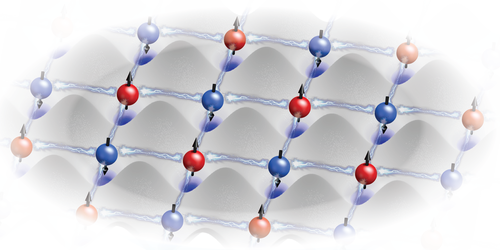Milestone for Optical-Lattice Quantum Computer
Ultracold atoms trapped in an optical lattice—a periodic array of laser-produced trapping sites—could potentially be used to perform quantum computations and should be scalable, according to experts. But until now researchers had failed to accomplish a critical step: quantum mechanically entangling more than two atoms at a time. Now Jian-Wei Pan of the University of Science and Technology of China and his colleagues have entangled one-dimensional chains of ten atoms and two-dimensional groups of eight atoms with high reliability [1]. The team has also demonstrated control and imaging of the states of the atoms with single-atom resolution [1]. The results show that several of the required building blocks needed for optical-lattice-based quantum processors are now practical.
Previously, Pan and his colleagues have entangled pairs of atoms in a system containing over 2000 rubidium atoms [2]. In that experiment they used a two-dimensional lattice that had two trapping locations at each lattice site—a so-called superlattice. To entangle larger numbers of atoms, the researchers again used the superlattice. They also used additional technologies: a so-called quantum gas microscope and three digital micromirror devices, spatial light modulators with high spatial precision. These tools provided the team with the single-atom resolution needed to create and then verify the simultaneous entanglement of groups of up to ten atoms within the set of 100 or so atoms involved in these experiments. Single-atom resolution will ultimately be necessary for quantum computers, so that devices can manipulate individual qubits and read their values.
–David Ehrenstein
David Ehrenstein is a Senior Editor for Physics Magazine.
References
- W.-Y. Zhang et al., “Scalable multipartite entanglement created by spin exchange in an optical lattice,” Phys. Rev. Lett. 131, 073401 (2023).
- H.-N. Dai et al., “Generation and detection of atomic spin entanglement in optical lattices,” Nat. Phys. 12, 783 (2016).




